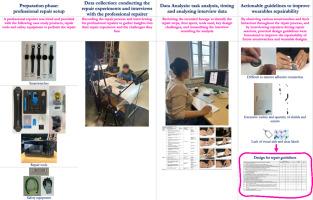评估智能手表的维修设计:来自专业修理工的见解
IF 10.9
1区 环境科学与生态学
Q1 ENGINEERING, ENVIRONMENTAL
引用次数: 0
摘要
大多数现有的可修复性评估依赖于预定义的标准和评分系统,这些标准和评分系统评估诸如文档、工具可访问性、备件可用性和易于拆卸等因素。虽然这些方法能够对产品进行系统的基准测试,但它们是由制造商、工程师或监管机构在受控或理想化的条件下进行的,无法捕捉专业维修人员面临的真正挑战。本文章由计算机程序翻译,如有差异,请以英文原文为准。

Assessing smartwatches for design for repair: insights from a professional repairer
Most existing repairability assessments rely on predefined criteria and scoring systems that evaluate factors such as documentation, tool accessibility, spare parts availability, and ease of disassembly. While these methods enable systematic benchmarking across products, they are conducted under controlled or idealized conditions by manufacturers, engineers, or regulators and do not capture the real challenges professional repairers face.
This study addresses this gap by applying a product ethnography approach, directly observing a professional repairer working on the top five smartwatches in the UK market–Apple, Samsung, Fitbit, Garmin, and Huawei–with a specific focus on harvesting and replacing batteries, screens, and straps, as these are the top three high-wear parts. The repair process was analyzed through task analysis, timing, and interviews with the professional repairer.
This approach enables the identification of nuanced, real-world challenges that scoring-based methods often overlook, providing a deeper understanding of how product design affects practical repairability beyond what theoretical metrics can reveal.
The analysis revealed recurring design barriers, including strong adhesives, fused assemblies, a high number of internal supports, shields, and tapes, and shell designs that require unnecessary screen removal to access batteries. Further challenges arose from nested and dependent design, misleading layouts, minimal alignment or orientation cues, and clusters of small, similar-looking parts that complicate sequencing and reassembly.
Based on these insights, a set of practical design guidelines grounded in real-world repair is proposed to help manufacturers enhance the repairability of future smartwatches and wearables.
求助全文
通过发布文献求助,成功后即可免费获取论文全文。
去求助
来源期刊

Resources Conservation and Recycling
环境科学-工程:环境
CiteScore
22.90
自引率
6.10%
发文量
625
审稿时长
23 days
期刊介绍:
The journal Resources, Conservation & Recycling welcomes contributions from research, which consider sustainable management and conservation of resources. The journal prioritizes understanding the transformation processes crucial for transitioning toward more sustainable production and consumption systems. It highlights technological, economic, institutional, and policy aspects related to specific resource management practices such as conservation, recycling, and resource substitution, as well as broader strategies like improving resource productivity and restructuring production and consumption patterns.
Contributions may address regional, national, or international scales and can range from individual resources or technologies to entire sectors or systems. Authors are encouraged to explore scientific and methodological issues alongside practical, environmental, and economic implications. However, manuscripts focusing solely on laboratory experiments without discussing their broader implications will not be considered for publication in the journal.
 求助内容:
求助内容: 应助结果提醒方式:
应助结果提醒方式:


